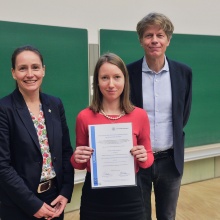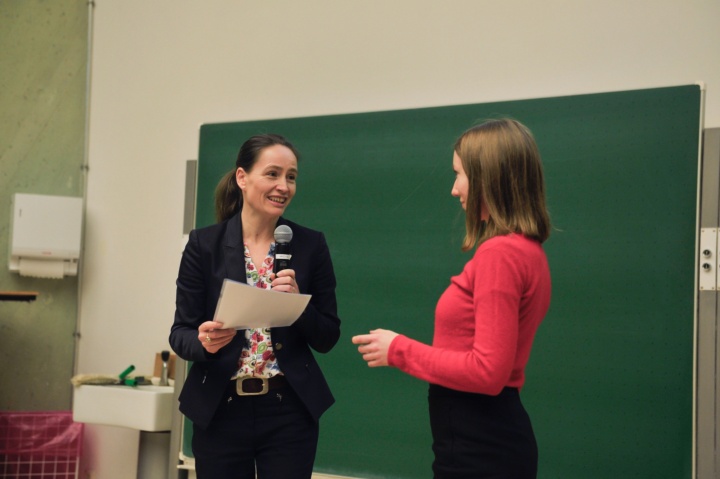The University of Stuttgart has awarded the Prima! Prize since 2014 to honor excellent theses by female graduates. The aim of this is to encourage and support women towards embarking on a scientific career. For the past three years, the certificate has been awarded as part of the Research Day celebrations. On January 31, the Prima! Prize was awarded to Anna Schwarz. She tells us in an interview what’s special about her work.
1. Can you explain what the topic of your master’s thesis is and classify it in a broader research context?
The topic of the master’s thesis is the prediction of shock waves based on simulation data from currents. A shock wave is a phenomenon which leads to an abrupt change in aerodynamic variables such as pressure. This behavior can influence both the performance and the structure of an aircraft. Imagine that we’re flying on an airplane and we’re sitting by the window with views of the wing. The air, which flows around the aircraft, becomes faster at the wing tips, which forms shock waves. These lead to the creation of swirls, which increase the resistance, which in turn leads to an increase in fuel consumption.
This makes an understanding of these phenomena essential. It is possible to simulate the flow characteristics. With these kind of numeric simulations, which refer to an attempt to reproduce what happens on the computer, the shock waves must be recognized reliably and be treated appropriately. Previously, this recognition was strongly dependent on the parameters and required a lot of experience, or in some cases, the only possible solution was by pure trial and error. In my master’s thesis, I developed a new shock detector based on image recognition methods such as e.g. neuronal networks. This requires no input and no knowledge on the part of the user, and in some cases is even more exact than the methods which existed previously.
2. What made you decide on this topic and what is it about it that you find exciting?
I was interested in the interface between numeric methods and machine learning, which I haven’t come across yet during my university studies. A neuronal network is an algorithm used in machine learning which can also be used for image recognition purposes. A simple example would be that you give a neuronal network 200,000 pictures of cats and 200,000 pictures of dogs. Then you tell the network that every picture of a cat is a cat and every picture of a dog is a dog. This is how the neuronal network “learns” to identify cats and dogs in pictures.
Transferred to my master’s thesis, this means that if you give the neuronal network pictures of shock waves and pictures of airflows without shock waves, then it would also know what a shock is. This way, it “learns” to predict shocks.
3. Why would you recommend studying for a degree in aerospace engineering?
I would recommend everybody to study what interests them the most. If somebody is interested in aerospace engineering or engineering in general then I can only recommend it to them because it opens up a lot of opportunities, e.g. the chance to spend time working abroad, and because of the wide range of subject areas even outside aerospace.
4. What made you choose this study program?
Before I started I was interested in math, physics, chemistry and computer science as well, and this study program combines all these subjects together.
5. What do you see yourself doing in future?
In the future, I hope to be working on exciting and varied projects, either at the university or in industry.



